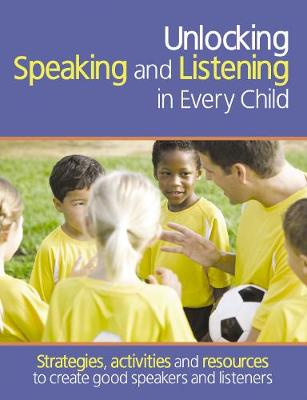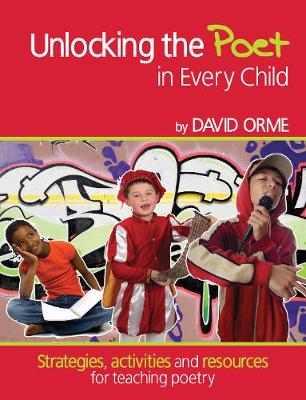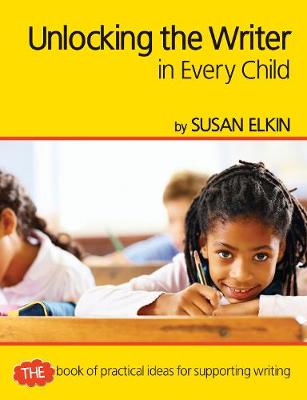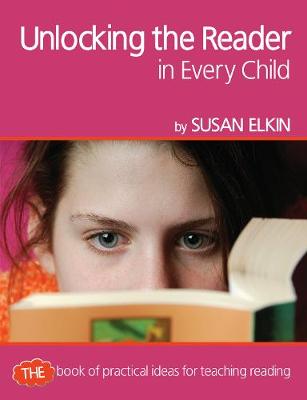Professional Development in Literacy
5 total works
Professional Development Pack for Literacy
by Steve Rickard, Susan Elkin, Mary Hopper, and David Orme
Published 27 August 2015
This pack includes a range of practical books for literacy teachers, librarians and others working in literacy.
Each book focuses on a key literacy topic with an emphasis on providing practical suggestions that can be implemented in the classroom. The books are easy to dip into and browse for fresh perspectives and new ideas. Each topic is covered in two ways: first with a broad overview of the topic, covering basic, quick-to-read guides to teaching each of the key areas of literacy and drawing on best practice over the years.
The section part of each is book is a toolkit. It includes practical activities and games, photocopiable sheets and many other resources.
The pack includes:
Unlocking the Reader in Every Child
Unlocking the Writer in Every Child
Unlocking the Poet in Every Child
Unlocking Speaking and Listening in Every Child
These books cover the essential topics in literacy in a powerful, clear way with real authority.
Each book focuses on a key literacy topic with an emphasis on providing practical suggestions that can be implemented in the classroom. The books are easy to dip into and browse for fresh perspectives and new ideas. Each topic is covered in two ways: first with a broad overview of the topic, covering basic, quick-to-read guides to teaching each of the key areas of literacy and drawing on best practice over the years.
The section part of each is book is a toolkit. It includes practical activities and games, photocopiable sheets and many other resources.
The pack includes:
Unlocking the Reader in Every Child
Unlocking the Writer in Every Child
Unlocking the Poet in Every Child
Unlocking Speaking and Listening in Every Child
These books cover the essential topics in literacy in a powerful, clear way with real authority.
Unlocking speaking and listening skills is crucially important in the development of a child's literacy and communication abilities. Good communication improves performance, is more rewarding for the individual and builds self-esteem.
Speaking and listening is now higher on the teaching agenda than ever before, but many teachers still find it a difficult subject to tackle. Many are not sure what's involved and how to teach it. As a result, its a topic that is all-too-often neglected.
This book, the fourth in Ransom's practical series of handbooks for teachers brings focus and clarity to the subject. Mary Hoppeer provides structures that enable teachers to teach it effectively and she shows how improved speaking and listening can bring benefits in all subject areas. Put simply children who speak and listen well are better all-round learners.
Produced in the same highly practical way as other books in the Unlocking series, the book includes sections covering developing listening skills, speaking for a purpose, structuring group discussions, building self-esteem and social skills, word games, language play and assessing speaking and listening.
Topics include:
talking about talk: 'spoken texts', speaking for a range of practical purposes
learning to listen: listening, evaluating and responding
structuring speaking and listening sessions
types of talk: discussing and persuading; informing, explaining and instructing; and recounting, imagining and retelling
meeting individual needs
using speaking and listening to support reading and writing
speaking and listening through the curriculum.
Unlocking Speaking and Listening in Every Child brings together the best of teacher's resources to help develop speaking and listening for children in a practical, interesting way. Written by expert Mary Hopper, this book is essential for teachers who want to develop their own understanding and abilities on this topic.
Speaking and listening is now higher on the teaching agenda than ever before, but many teachers still find it a difficult subject to tackle. Many are not sure what's involved and how to teach it. As a result, its a topic that is all-too-often neglected.
This book, the fourth in Ransom's practical series of handbooks for teachers brings focus and clarity to the subject. Mary Hoppeer provides structures that enable teachers to teach it effectively and she shows how improved speaking and listening can bring benefits in all subject areas. Put simply children who speak and listen well are better all-round learners.
Produced in the same highly practical way as other books in the Unlocking series, the book includes sections covering developing listening skills, speaking for a purpose, structuring group discussions, building self-esteem and social skills, word games, language play and assessing speaking and listening.
Topics include:
talking about talk: 'spoken texts', speaking for a range of practical purposes
learning to listen: listening, evaluating and responding
structuring speaking and listening sessions
types of talk: discussing and persuading; informing, explaining and instructing; and recounting, imagining and retelling
meeting individual needs
using speaking and listening to support reading and writing
speaking and listening through the curriculum.
Unlocking Speaking and Listening in Every Child brings together the best of teacher's resources to help develop speaking and listening for children in a practical, interesting way. Written by expert Mary Hopper, this book is essential for teachers who want to develop their own understanding and abilities on this topic.
This unique book contains poetry teaching strategies, differentiated poetry activities and a coherent poetry anthology - all organised as one coherent resource.
This is the definitive book for teaching and supporting poetry in the classroom. The value of poetry to children is enormously undervalued. It provides a huge variety of models for writing, as well as providing opportunities to consider grammar and punctuation in action, and to widen vocabulary. It supports many other aspects of literacy by making links with other curriculum areas, exploring points of view and justifying opinions. For students still insecure in their reading, poetry offers repetition and memorability. It is a great loss to children that poetry is not used more extensively in supporting literacy.
The book is in three parts:
Part One discusses strategies for teaching poetry - covering reading, listening and performing, writing and poetry assessment.
Part Two contains over 60 poetry activity ideas, clearly differentiated, each with accompanying poetry texts (written by the author) to support the activity.
Part Three comprises an anthology of poems, organised by type of poem rather than by subject, to support poetry in the classroom.
This is a must have book to support the teaching of poetry and a great accompaniment to Unlocking the Reader in Every Child.
This is the definitive book for teaching and supporting poetry in the classroom. The value of poetry to children is enormously undervalued. It provides a huge variety of models for writing, as well as providing opportunities to consider grammar and punctuation in action, and to widen vocabulary. It supports many other aspects of literacy by making links with other curriculum areas, exploring points of view and justifying opinions. For students still insecure in their reading, poetry offers repetition and memorability. It is a great loss to children that poetry is not used more extensively in supporting literacy.
The book is in three parts:
Part One discusses strategies for teaching poetry - covering reading, listening and performing, writing and poetry assessment.
Part Two contains over 60 poetry activity ideas, clearly differentiated, each with accompanying poetry texts (written by the author) to support the activity.
Part Three comprises an anthology of poems, organised by type of poem rather than by subject, to support poetry in the classroom.
This is a must have book to support the teaching of poetry and a great accompaniment to Unlocking the Reader in Every Child.
The essential companion to the successful Unlocking the Reader, this new book focuses on the often neglected area of writing. It follows the same format as its predecessor, offering explanation, tips and guidance, alongside practical activities to engage and support writing.
It provides a basic, quick to read guide to teaching and supporting writing of all kinds, drawing on best practice over the years. Covering everything from fiction to poetry, news articles to diaries, blogs and even epitaphs, this book is rich in creative writing ideas.Individual chapters focus on writing fiction, poetry and drama, writing for practical purposes (including persuasive writing) and writing in the digital world. A specific chapter also addresses special needs issues in writing.
But this book is not just a guide. It's a toolkit too. Each section contains practical activities, games and 'try this' ideas to help develp writing skills and overcome obstacles. It tackles age-old topics in new ways. As with reading, learning to write needs support and continual practice at all ages, and this book offers activity ideas for children learning to write, from beginners right up to post-16 years.
There are games and activities to:
develop motor skills and improve coordination
develop handwriting
support writing using computers, smartphones and tablets
stimulate writing for different purposes
meet individual needs (including children with specific learning difficulties).
Specific chapters cover author visits to schools and publishing children's work. A dedicated section also addresses digital writing opportunities, including using blogs, mobile devices and social networking sites such as Twitter.A final chapter covers the basics of orthography, providing a quick reference to the correct use of English.
Every page offers some fresh perspectives to try - either at home or in the classroom. This is the ideal book for teachers to develop children's writing skills.
It provides a basic, quick to read guide to teaching and supporting writing of all kinds, drawing on best practice over the years. Covering everything from fiction to poetry, news articles to diaries, blogs and even epitaphs, this book is rich in creative writing ideas.Individual chapters focus on writing fiction, poetry and drama, writing for practical purposes (including persuasive writing) and writing in the digital world. A specific chapter also addresses special needs issues in writing.
But this book is not just a guide. It's a toolkit too. Each section contains practical activities, games and 'try this' ideas to help develp writing skills and overcome obstacles. It tackles age-old topics in new ways. As with reading, learning to write needs support and continual practice at all ages, and this book offers activity ideas for children learning to write, from beginners right up to post-16 years.
There are games and activities to:
develop motor skills and improve coordination
develop handwriting
support writing using computers, smartphones and tablets
stimulate writing for different purposes
meet individual needs (including children with specific learning difficulties).
Specific chapters cover author visits to schools and publishing children's work. A dedicated section also addresses digital writing opportunities, including using blogs, mobile devices and social networking sites such as Twitter.A final chapter covers the basics of orthography, providing a quick reference to the correct use of English.
Every page offers some fresh perspectives to try - either at home or in the classroom. This is the ideal book for teachers to develop children's writing skills.
Required reading for the TES online CPD literacy courses, this is an essential book for every literacy teacher and student.
It provides a basic, quick-to-read guide to teaching reading, drawing on best practice over the years. But it is not just a guide. It is a toolkit too. Each section includes practical activities, games and 'try this' ideas to help develop reading skills and overcome obstacles.
Every page offers some fresh perspectives to try - either at home or in the classroom- all with a practical focus. There are games and activities to:
build phonological awareness
turning decoders into real readers
help strugglers
overcome resistance to reading
harness visual literacy and children's passions
meet individual needs (including children with specific learning difficulties) and
achieve literacy outcomes without even teaching literacy.
This is a book that everyone working in literacy should own! It supplies the best basic guides to teaching reading in an engaging and interesting fashion, presenting practical activities, games and ideas to help develop reading skills and overcome obstacles. It covers all the essential topics in a powerful, clear way with real authority to make the book extremely practical.
It provides a basic, quick-to-read guide to teaching reading, drawing on best practice over the years. But it is not just a guide. It is a toolkit too. Each section includes practical activities, games and 'try this' ideas to help develop reading skills and overcome obstacles.
Every page offers some fresh perspectives to try - either at home or in the classroom- all with a practical focus. There are games and activities to:
build phonological awareness
turning decoders into real readers
help strugglers
overcome resistance to reading
harness visual literacy and children's passions
meet individual needs (including children with specific learning difficulties) and
achieve literacy outcomes without even teaching literacy.
This is a book that everyone working in literacy should own! It supplies the best basic guides to teaching reading in an engaging and interesting fashion, presenting practical activities, games and ideas to help develop reading skills and overcome obstacles. It covers all the essential topics in a powerful, clear way with real authority to make the book extremely practical.




